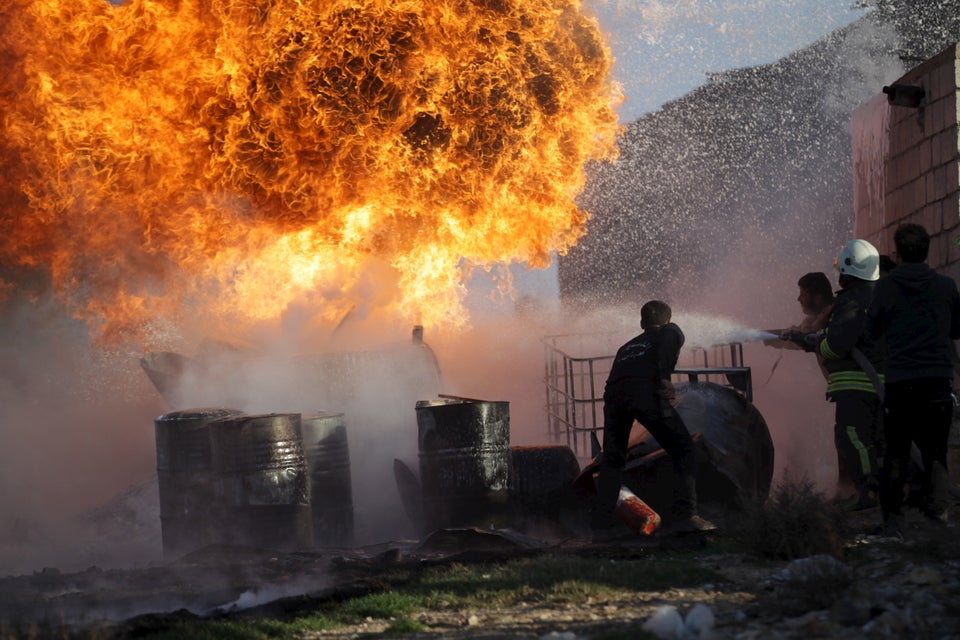
Every week, The WorldPost asks an expert to shed light on a topic driving headlines around the world. This week, we speak with analyst and author Charles Lister on the rise of jihadist groups in the Syrian civil war.
Five years after the start of the Syrian civil war, a peaceful popular uprising against government injustice has given way to a conflict in which hundreds of thousands people have died and significant parts of the country are in the hands of jihadist militant groups.
In his new book The Syrian Jihad, author and analyst Charles Lister chronicles the rise of jihadist militias in the country. The book is an incredibly detailed look at how these groups, including the al Qaeda affiliate Jabhat al Nusra and the self-described Islamic State, have shaped the brutal conflict. Lister also goes back to before the start of Syria's uprising in 2011 and shows how both Bashar Assad and the U.S.-led invasion of Iraq contributed to the militants' rise.
Lister is currently a senior consultant at The Shaikh Group and resident fellow at the Middle East Institute. The WorldPost spoke with him last week on his book, the origins of Syria's jihadist movements and the need to understand the complexities of the war.
In the book you detail how jihadist elements existed in Syria well before the revolution and were supported by the state. Could you expand on how the Assad regime cultivated these elements?
The best example is essentially what developed during the U.S. invasion and occupation of Iraq from the very first days of the invasion.
In March 2003, Syria's state-appointed Grand Mufti Sheikh Ahmad Kaftaru issued a fatwa in which he basically made it obligatory for all male and female Muslims anywhere in the world, and particularly in Syria, to join a jihad against the U.S.-led occupation.
The Grand Mufti was specifically appointed by Assad as a regime-loyal religious figure. His word carried an awful lot of weight, not just because of his religious leadership, but also because of his relationship with the state. In the first 11 days after the occupation, up to 5,000 foreign fighters traveled from Syrian territory into Iraq. Almost all of those were Syrian. On the 12th day, almost 1,000 Palestinian Syrians came from the Yarmouk refugee camp. Nearly all of these people were transported in government-run buses to the Iraqi border. Syrian border guards were ordered to stand down, and on the Iraqi side, there were no border guards, or very few at least, left after the invasion.
“In the first 11 days after the occupation, up to 5,000 foreign fighters traveled from Syrian territory into Iraq. Almost all of those were Syrian.”
In those immediate days of the invasion, state complicity was very clear. What was less immediately clear and sort of more below the surface were the relationships established between Syrian military intelligence and prominent jihadist figures in various parts of Syria.
The most famous of those was a man called Abu al Qaqaa, whose real name was Mahmoud Ouul al-Ghasi. He had been in the pocket of Syrian intelligence at least since 1999, and he was operating out of a mosque in Aleppo city.
He was the one who organized a festival to celebrate the 9/11 attacks.
Exactly. After 9/11, Abu al Qaqaa and his movement in Aleppo, known as Ghurabaa al Sham, held a large festival celebrating the 9/11 attacks and showing footage of his followers receiving military training. Part of that festival was aired on Syrian state TV, and the festival itself gained a lot of regional attention.
The blowback from that festival forced the regime to temporarily arrest Abu al Qaqaa, but of course, he was only in detention for 24 hours and then released and allowed to continue his activities as normal.
Abu al Qaqaa was a key figurehead in the initial mobilization of jihadists from Syria to Iraq. Later on, he was a key mobilizing figure for jihadists around the region to travel to Syria and then, with military facilitation, travel into Iraq. There are various other figures like that, but Abu al Qaqaa is the most famous.

How did the Assad regime benefit from cultivating these jihadist elements, a kind of appeasement of these forces within Syria?
From the late 1990s until 2003, the regime was aware some [jihadist] movement was probably going to develop and was emerging elsewhere in the region as well. I assume a decision was made to acquire sources within the movement -- especially senior ones -- to keep it from becoming a threat against the Syrian state but to allow it to develop with some extent of control.
By 2003, the danger was that Abu al Qaqaa in particular had developed such power that the regime started to considered [his group] a potential threat. In that sense, the invasion of Iraq came at a perfect time, because it allowed the regime to export a developing domestic threat and use it to pursue Syrian foreign policy agendas, in that case, fighting against the Americans.
But that eventually blew back against them.
Eventually. Exporting these jihadists to Iraq helped develop al Qaeda in Iraq, which became ISIS or the Islamic State. But, in that whole intermediate period between 2003 and 2011, the regime showed a capacity to largely successfully manage the return and re-exporting of jihadist fighters to prevent them from becoming a domestic threat.
“Exporting these jihadists to Iraq helped develop al Qaeda in Iraq, which became ISIS or the Islamic State.”
But of course, it backfired in 2011 and from the revolution onward. The very kind of jihadist infrastructure and networks that the regime had explicitly helped create and facilitate within its own territory became the building blocks that allowed first Jabhat al Nusra and then ISIS to establish themselves within the conflict itself. That has come to represent, basically, the chickens coming home to roost.
Initially, opposition forces were very suspicious and rejected support from jihadist groups, but now these groups are inextricable from the opposition. What changed that merged the two?
The conflict evolved from one involving a series of opposition militias to one involving large-scale insurgent movements. During that evolution, the conflict itself intensified in scale. That necessitated an opposition that was willing to accept the help of anyone that demonstrated a willingness to fight for the revolutionary cause. That was a vacuum, or a space, that Nusra very willingly filled from around late 2012 onwards.
By consciously restraining the extent to which it showed its real face as an al Qaeda affiliate and by embedding itself in the revolutionary dynamics, Nusra ensured that it would become an indispensable part in the fight against the regime.
In that sense, as long as conflict continues, Nusra will continue to enjoy that dependent relationship that it has established with the broader opposition. It doesn’t mean that the opposition agrees with what Nusra represents, it's just the intensity of the conflict and the lack of any better alternative that necessitates it.

Do you think the international community, specifically the U.S., missed a key window to arm more moderate rebels in the Free Syrian Army before more powerful jihadist groups took over the conflict?
Hindsight is an amazing thing. If the West in general, and the United States specifically, had not only better understood, but also better engaged with the emerging opposition in 2012 -- and decided that backing them was a more favorable alternative to allowing the conflict to gain in complexity -- then yes, absolutely it should have been done.
The very fact that the moderate opposition never succeeded in representing itself as a single body with a single command structure -- and the fact that the western world used that as an excuse to restrict its support for the opposition -- allowed Jabhat al Nusra to represent itself as a stalwart ally of the revolution.
Nusra’s consistent line has been that the western world does not care about the revolution or about Sunni Muslims in Syria, but “we” do. It is our fault for not providing a better vision and a more credible alternative, which I know for a fact they would have taken back in 2012, 2013.
What do you believe to be the biggest misconception when it comes to the common narrative of Syria’s civil war?
Syria’s civil war is undoubtedly complex -- amazingly complex -- but dealing with it successfully on a policy level means engaging in that complexity, accepting the complexity and working with it. Unfortunately, complexity has been used as an excuse for taking a step back from Syria.
Another thing that has consistently frustrated me is that the western world and certainly policy-making circles have consistently misunderstood opposition actors. The one thing I have learned from engaging face-to-face with these opposition groups is not only how nationalist the vast majority of them are, but also how united the armed opposition is in general.
“Unfortunately, complexity has been used as an excuse for taking a step back from Syria.”
The idea that the armed opposition is riddled with divisions and infighting, led by corrupt people and dominated by jihadist groups is just patently false. But unfortunately those perceptions have developed, or at least been enforced, by the relative inaccessibility of actually getting to these people and groups. Certainly from researching the book and interviewing the various people I have for it, that’s the biggest lesson I’ve had.
Many of these people are so misunderstood, and the fact that we’ve perceived them as something that they are not has contributed to the mess we see today.
This interview took place on March 10. It has been edited for length and clarity.
Read more HuffPost interviews on the conflict in Syria:
The Terror Group That Could Ruin Syria's Ceasefire Isn't ISIS
Inside The Islamic State's Apocalyptic Beliefs
Russia Says Its Airstrikes In Syria Are Perfectly Legal. Are They?

